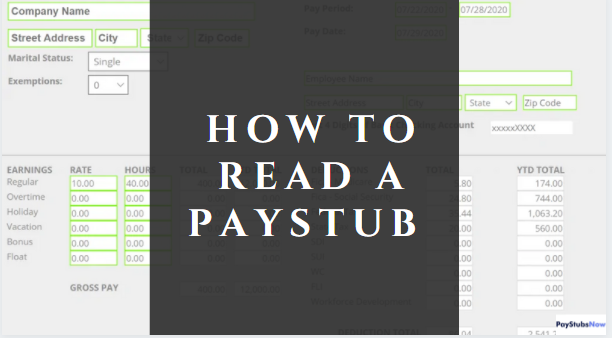Reading paystubs can be complicated if it is your first time. It is easy and common practice to just take a look at the bolded numbers, see how much your take-home is, and that’s it. This is why we have created an abridged and simplified version of how to read a paystub. With this article, you can now understand the otherwise technical jargons you never understood on your paystubs. If you are yet to know what a paystub is, you can do so here.
Why You Need To Understand Wage Deductions?
There are often loads of deductions labeled all over a paystub. This gives you a clear picture of why your paycheck is as it appears. With these inclusions, you can track what you are paying for tax, medicare, and others. It is also your responsibility as an employee to report inaccuracies on your paystubs. The last thing you want is to find out an error that has spanned over several pay periods. This is why understanding how to read a paystub is very important.
Reading paystubs
Other than basic information such as employee name and ID and social security number, below is a breakdown of everything you will typically see on a paystub and what they mean.
Pay period and pay date
This is the period for which you are being paid and the date payment was made. This allows you to keep a detailed record of your earnings should you need to go back to them.
Gross income
This is how much you earned before any form of deductions is taken out.
YTD
YTD is an acronym for year-to-date. You will find this in almost any paystubs. It is a summary of your gross income, net incomes, and deductions from the start of the year till the present.
Net income
Also known as your take-home-pay. This is the amount deposited into your bank account after all deductions have been made.
Federal tax
Amount deducted per period for federal income tax. This saves you the hassle of having a large tax bill on your hand.
Social Security tax
A social security tax deduction is a part of the Federal Insurance Contributions Act (FICA). It provides benefits for the disabled and retired workers. You and your employer contribute to this cause. Your social security tax shows your deducted share.
FICA Medicare
This is a deduction made for medicare tax. If you aren’t familiar with the concept, medicare is an insurance program for people who are 65 or older, people with permanent kidney disease, and certain younger people with disabilities.
State tax
Not all states have income taxes. For those that do, your state income tax is deducted by your employer per period. This saves you from paying a large sum when you file your tax return.
State unemployment tax (SDI)
SDI is a state deduction on your overall paycheque. This deduction is used to provide temporary support for state workers who have lost their jobs. As a state tax, this deduction is restricted to only some states.
State disability insurance (SDI)
Also called temporary disability tax (TDI) in some states. This is also a state deduction restricted to a few states. This deduction is used to help fund short-term disability benefits for workers who become disabled.
Family leave insurance (FLI)
Family leave insurance popularly inscribed as FLI on your paystub is a mandatory withheld deduction. However, it is part of state deductions and does not apply to all states or employers.
Final Thought
Paystubs have different requirements across different states. If there are inaccuracies on your paystub or you see something you don’t understand, contact your payroll provider. This could be the accounting department in your firm or employer. You can also find the best paystub generator here.



